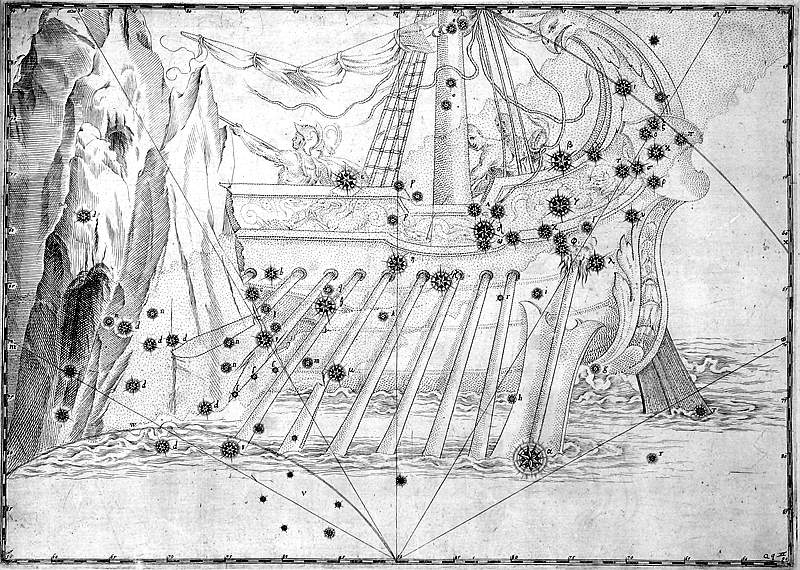One of the three sections into which the French astronomer Nicolas Louis de Lacaille divided the Greek constellation of Argo Navis, the Argonauts’ ship, in his southern star catalogue of 1756. Vela represents the ship’s sails; the other sections are Carina, the Keel, and Puppis, the Stern. Lacaille wrote: “I have called the sails everything outside the vessel between the edges and the horizontal mast, or the spar on which the sail is reefed”.
-
Vela - The Sails
Traditionally, the sail of Argo has been shown furled around a cross-spar on the main mast, as in this early illustration from the Uranographia of Johann Bayer in 1603, and not open and billowing as imagined in some popular representations.
© Tartu Observatory Virtual Museum.
Not only did Lacaille dismantle Argo Navis, he also relabelled its stars, since he was dissatisfied with Bayer’s arrangement. But he still used only one set of Greek letters for all three parts of Argo. As a result, Vela possesses no stars labelled Alpha or Beta, since these stars were allocated to the two brightest stars in Carina. Vela’s brightest star is Gamma Velorum, a second-magnitude double star.
Chinese Associations
Five stars in Vela formed the Chinese constellation Ji, representing a temple to Hou Ji, the god of cereals. Ji itself refers to millet, which was the main crop in ancient China. However, the exact stars involved are uncertain.
Even greater uncertainty surrounds other Chinese constellations in this far southern area of sky. One such is Tianshe, ‘celestial altar’. In Chinese fable, Tianshe represented an altar used to make offerings to the Earth god Julong. One version identifies its six stars as Gamma, b, Omicron, Delta, Kappa and N Velorum. Sun and Kistemaker, though, depict it zig-zagging from Chi Carinae via Gamma Velorum and on into Puppis, while a third interpretation confines it to Puppis alone. Another problematic constellation is Qifu, a storehouse for musical instruments, consisting of 32 stars mostly in Centaurus but perhaps spilling over into Vela as well.
Two or three stars in northern Vela, including q and i, formed part of Dong’ou, which straddled the border with Antlia. This constellation was named after a place on the Chinese coast where barbarians were said to live.
One individual star in this region was known as Tianji, representing an assessor who decided whether animals were old enough to be sacrificed. This star has been identified either as Lambda Velorum or 12 Hydrae; the latter identification may be more probable as it would place it closer to the kitchen, Waichu, in Hydrae where the animals were actually slaughtered.
© Ian Ridpath. All rights reserved
Here is a Wikipedia article about the constellation.
